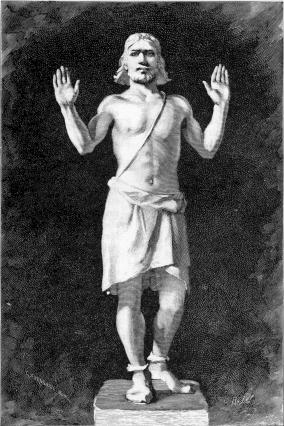Balder
Balder (also spelled Baldr or Baldur) is a god in Norse mythology, who is given a central role in the mythology of the Norse peoples of the late Viking Age. He is often considered the god of love, peace, forgiveness, justice, light, or purity in Norse mythology, but his role and characteristics are not uniformly described in the sources. Balder is the second son of Odin, the chief of the gods, and his wife Frigg, and has numerous brothers, such as Thor and Váli.
Mythology[edit | edit source]
According to the most detailed accounts in the Poetic Edda and the Prose Edda, written in the 13th century by Snorri Sturluson, Balder's most famous myth involves his death. Balder starts having foreboding dreams of his own demise, which lead his mother Frigg to extract an oath from all things in nature not to harm Balder. However, she overlooks the mistletoe, considering it too young and harmless to make an oath. Loki, the trickster god, learns of this omission and crafts a dart or arrow made of mistletoe. He then tricks Balder's blind brother, Höðr, into shooting Balder with it, leading to Balder's death.
Following Balder's death, the gods attempt to resurrect him from the underworld, a realm overseen by the goddess Hel. Despite their efforts, Balder remains in the underworld until after Ragnarök, the prophesied end of the world, after which he returns to live in a new world, reborn and purified.
Interpretations and Theories[edit | edit source]
Scholars have debated Balder's role and significance in Norse mythology. Some interpretations suggest that Balder's death symbolizes the loss of innocence and the inevitable coming of winter or hardship. Others see it as a mythological representation of the sun setting and rising again, reflecting the cyclical nature of the world. The myth of Balder has also been interpreted in the context of ritual sacrifice, suggesting that it may have had a role in Norse religious practices.
Legacy[edit | edit source]
Balder's story has had a lasting impact on culture and literature, inspiring various works in the modern era. He is often seen as a symbol of the tragic hero or the purity that is doomed to suffer. His myth has been referenced in numerous literary and artistic works, ranging from the plays of Henrik Ibsen to the poetry of Matthew Arnold.
In Popular Culture[edit | edit source]
In recent years, Balder has appeared in various forms of media, including video games, comic books, and television series, often reinterpreted in ways that diverge significantly from his traditional depiction in Norse mythology. These portrayals have contributed to a renewed interest in Norse myths and their adaptation in contemporary culture.
Search WikiMD
Ad.Tired of being Overweight? Try W8MD's physician weight loss program.
Semaglutide (Ozempic / Wegovy and Tirzepatide (Mounjaro / Zepbound) available.
Advertise on WikiMD
|
WikiMD's Wellness Encyclopedia |
| Let Food Be Thy Medicine Medicine Thy Food - Hippocrates |
Translate this page: - East Asian
中文,
日本,
한국어,
South Asian
हिन्दी,
தமிழ்,
తెలుగు,
Urdu,
ಕನ್ನಡ,
Southeast Asian
Indonesian,
Vietnamese,
Thai,
မြန်မာဘာသာ,
বাংলা
European
español,
Deutsch,
français,
Greek,
português do Brasil,
polski,
română,
русский,
Nederlands,
norsk,
svenska,
suomi,
Italian
Middle Eastern & African
عربى,
Turkish,
Persian,
Hebrew,
Afrikaans,
isiZulu,
Kiswahili,
Other
Bulgarian,
Hungarian,
Czech,
Swedish,
മലയാളം,
मराठी,
ਪੰਜਾਬੀ,
ગુજરાતી,
Portuguese,
Ukrainian
Medical Disclaimer: WikiMD is not a substitute for professional medical advice. The information on WikiMD is provided as an information resource only, may be incorrect, outdated or misleading, and is not to be used or relied on for any diagnostic or treatment purposes. Please consult your health care provider before making any healthcare decisions or for guidance about a specific medical condition. WikiMD expressly disclaims responsibility, and shall have no liability, for any damages, loss, injury, or liability whatsoever suffered as a result of your reliance on the information contained in this site. By visiting this site you agree to the foregoing terms and conditions, which may from time to time be changed or supplemented by WikiMD. If you do not agree to the foregoing terms and conditions, you should not enter or use this site. See full disclaimer.
Credits:Most images are courtesy of Wikimedia commons, and templates, categories Wikipedia, licensed under CC BY SA or similar.
Contributors: Prab R. Tumpati, MD

